Fahlman B.D. Materials Chemistry
Подождите немного. Документ загружается.

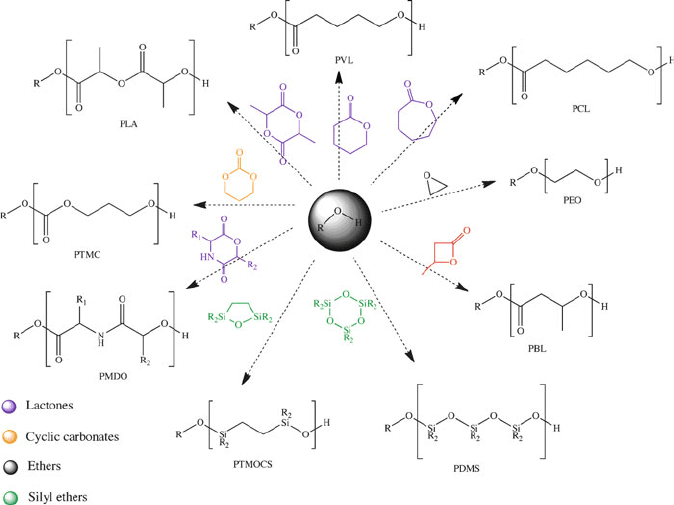
– Food packa ging (e.g., disposable plates, cups, bags, cutlery, bottles, retail bags,
six-pack rings)
– Hygiene (e.g., femin ine hygiene products, refuse bags, cups)
– Medical (e.g., suturing, fractured bone fixation, wound covering, skin/blood
vessel/nerve reconstruction, controlled drug delivery).
For biomedical applications, an implanted polymer may be designed to degrade at
an appropriate rate to transfer stress to surrounding tissues as they heal. This is
afforded by designing the bulk geometry of the implant, the chemical stability of the
polymer backbone, and the presence/concentration of additives such as plastici-
zers.
[60]
The degree of polymer crystallinity also plays a crucial role in its overall
degradation kinetics. For instance, whereas amorphous poly(dl-lactide), is 100%
degraded in 3–6 months, it may take 1–2 years for crystalline PLA to degrade under
analogous conditions. Accordingly, one may design a polymer with varying degrees
of crystallinity for time-delayed drug delivery applications.
[61]
The preferred use of
PLA for implantable biomedical applications is due to its high degree of bioresorp-
tion via degradation to lactic acid, which is metabolized through the Krebs cycle.
Accordingly, since its development in the 1960s, there are now more than 200
biomedical products made from PLA or PLA-based co-polymers.
Figure 5.45. Diverse applicability of novel N-heterocyclic carbene, bifunctional thiourea-amine, and
“superbase” catalysts for the polymerization of strained heterocyclics. Reprint courtesy of International
Business Machines Corporation, copyright 2009 # International Business Machines Corporation.
398 5 Polymeric Materials

To further illustrate the effect of polymer structure on its degradation (of impor-
tance for its viability for implant applica tions), let’s consider silicone breast implants
– developed by Dow Corning in 1961 and first implanted in 1962. Due to reports of
numerous health complications resulting from breast implants, countless class-
action suits were brought against Dow Corning in the mid-1980s – late-1990s.
[62]
The ensuing multi-billion dollar settlement in 1998 nearly caused the financial ruin
of Dow Corning Corporation.
[63]
One of the early generations of implants featured a
poly(ester urethane) (III) coating on the silicone shell, in order to prevent capsular
contracture – an abnormal response of the immune system to foreign materials.
However, due to the large numbers of ester linkages, this polymer was shown to
degrade resulting in carcinogenic aromatic amines such as 2,4-toluenediamine.
[64]
Limiting the number of ester groups (e.g., IV, poly(ether urethane) or V, poly(ester
urethane urea)) results in a significant improvement in the hyd rolytic stability of the
polymer. As shown by structures III–V, the polymeric coating must exhibit a tunable
Figure 5.46. Stepwise degradation routes for a biodegradable polymer via oxidative chemical reactions.
5.3. “Soft Materials” Applications: Structure vs. Properties 399
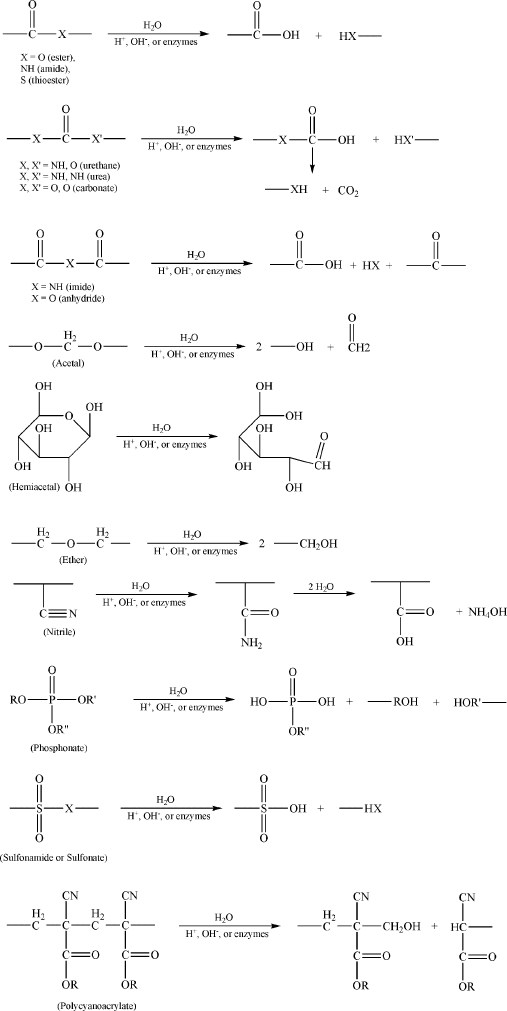
Figure 5.47. Degradation of various functional groups via hydrolytic chemical reactions.
400 5 Polymeric Materials
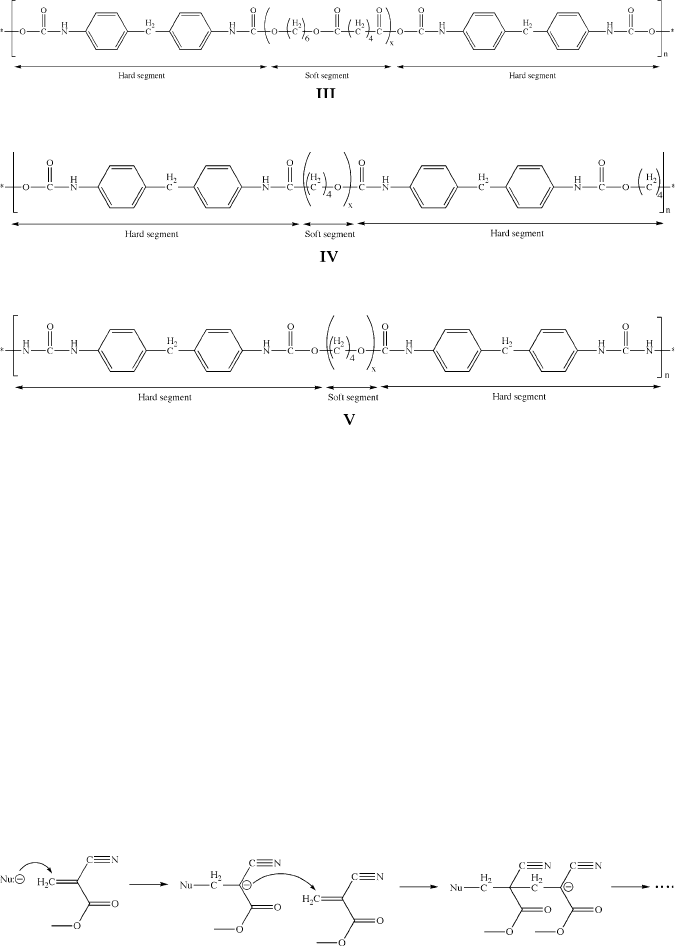
stiffness (“hard” and “soft” regions) that wi ll hold the silicone gel in place while
suitably interacting with the surrounding soft tissue.
For applications that require sealing or adhesion to tissues, liquids such as
2-cyanoacrylates are commonly used that rapidly cure to form an adhesive gel.
We are all familiar with the fast-setting ethyl-2-cyanoacrylate adhesive that is
sold under the trade name of Super Glue or Krazy Glue (ethyl-2-cyanoacrylate).
Veterinary glues employ n-butyl-cyanoacrylate (Vetbond and LiquiVet), whereas
medical grade adhesives such as LiquiBand, SurgiSeal, and Dermabond employ
2-octyl-cyanoacrylate. Polymerization is catalyzed by the presence of moisture;
chain initiation occurs via the nucleophilic attack of the ethylenic carbon by
hydroxide ions (Figure 5.48). The fast-setting properties of the monomer to form a
strong water-proof polymer (often in <1 min) is due to the presence of additives
such as toluidine (o-methylaniline, or 2-aminotoluene; C
6
H
4
(NH
2
)(CH
3
)).
Another important application for biodegradable polymers is the design of
arterial stents, used to prevent or counteract restricted blood flow that may lead to
heart attacks or strokes if left unaddressed. Every year, over 800,000 angioplasty
procedures are performed in the U.S., consisting of expanding the lumen of the
coronary artery with a balloon.
[65]
Though this is a more desirable option to coronary
Figure 5.48. Mechanism for the polymerization of methyl-2-cyanoacrylate, catalyzed by the nucleophilic
attack of OH
.
5.3. “Soft Materials” Applications: Structure vs. Properties 401
bypass surgery, ca. 30–50% of angioplasty patients soon develop significant
narrowing of the artery through migration and nucleation of smooth muscle cells,
known as restenosis.
In order to offset the high restenosis rate following angioplasty, scaffolding devices
known as endoprostheses or stents have been used in recent years to facilitate fluid
flow through a diseased coronary artery.
[66]
However, ca. 10–50% of patients receiving
stents still develop restenosis; consequently, patients must receive close monitoring
(and possible additional treatment) long after the surgery is performed.
[67]
Magnetic
resonance imaging (MRI) is emerging as a preferred method to detect, diagnose, and
monitor the formation of dangerous plaques within arteries. However, most stents are
comprised of metal alloys, which produce distortion in MR images. In order to
circumvent these problems, DeSimone and coworkers at the University of North
Carolina at Chapel Hill have developed stents that are comprised of biodegradable/
erodable polymers.
[68]
Most importantly, these stents may contain a variety of agents
(e.g., sensitizers, dissolution inhibitors, photo-acid generators, thermally-, pH-, irradi-
ation-, or light-activated catalysts, etc.) that allows one to achieve a controllable rate of
degradation. In addition, the stent has also been shown to effectively elute a drug such
as everolimus – an immunosuppressant used to prevent restenosis.
[69]
Studies showed
that the stent was completely bioabsorbed in patients after 2 years after implantation,
with full restoration of vasomotion (ability of the blood vessel to contract/expand). Due
to the drug-eluting properties of the stent, patients had a 0% rate of stent thrombosis
(blood clot formation). This work sets an amazing precedent for “smart” implantable
devices, which perform their designed function(s) and then completely disappear
without any side-effects!
Contact lenses
The concept of contact lens es was first reported by Leonardo DaVinci (1508) and
Rene Descartes (1632). However, it wasn’t until the late 1800s that the first contact
lenses were developed by Muller, Fick, and Kalt.
[70]
The lenses were comprised of
blown glass, being molded from rabbit and cadaver eyes.
[71]
While these early
designs prove d to be successful for eye protectio n and vision correction, you
might imagine that a piece of glass covering the entire eye would be quite uncom-
fortable. In fact, there are reports that the pain resulting from wearing these lenses
was so intense that a cocaine-based anesthetic was required!
[72]
It is easy to get overwhelmed when one considers the requisite properties of
contact lenses. In addition to being fabricated inexpensively and reproducibly, the
lenses must also be biocompatible. That is, the polymers used in modern lenses must
be capable of being in direct contact with the eye for an extended duration, as well as
produced in such a way that any residual monomer/additive/catalyst does not pose a
health risk. Further, since the lens floats on a layer of water known as the tear film,
the polymer must be hydrophilic (especially for extended-wear varieties), while
resisting the deposition of other components contained in tear drops such as protein,
lipids, ions (e.g., Na
+
,Ca
2+
, HCO
3
), and enzymes.
[73]
In addition, the lens must be
lightweight with sufficient mechanical strength to avoid being torn or scratched; of
course, this must be balanced with a relatively high modulus of elasticity to facilitate
402 5 Polymeric Materials

overall comfort when in use and ease of handling. The thickness of the lens must be
optimized to afford the desired optical correction and gas permeability (sufficient O
2
supply and CO
2
removal), while not interfering with eyelid functions. Lastly, the
specific weight of the lens must be of the same order of magnitude as tear drops, so it
will not migrate around the corneal surface. With so many property constraints,
contact lens design repr esents a remarkable chal lenge for zealous materials chemists
and scientists!
The first plastic (‘hard’) corneal contact lens was developed in 1936, fabricated
from poly(methyl methacrylate), PMMA (VI).
[74]
However, these lenses were not
commercially available until the mid 1960s. In comparison, ‘soft’ contact lenses
were first comprised of poly(hydroxyethyl methacrylate), PHEMA (VII), and became
commercially available shortly thereafter. Both types of lenses are comprised of a 3-D
amorphous network of cross-linked polymer chains. However, the ‘soft’ vs. ‘hard’
character of a lens material is directly related to the ambient operating temperature
relative to its glass-transition temperature (T
g
). Whereas PMMA has a T
g
of
100–120
C, the T
g
of PHEMA (ca. 10–15
C) lies below room temperature.
[75]
The first type of hard contact lens was fabricated exclusively from PMMA. These
lenses are hydrophobic, which effectively repels protein build-u p; however, these
5.3. “Soft Materials” Applications: Structure vs. Properties 403
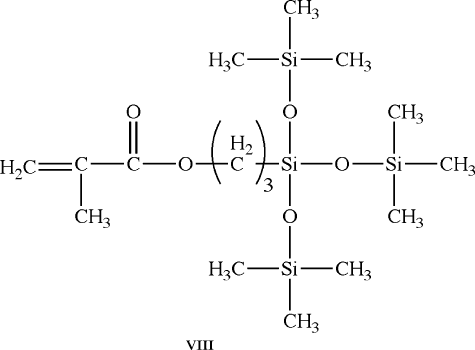
materials are impermeable toward gases such as O
2
and CO
2
. Due to the lack of
blood vessels within the cornea, the cornea must obtain oxygen directly from the
atmosphere. Hence, it is essential to afford the highest level of oxygen diffusion
through the lens in order to prevent hypoxia and promote corneal health by avoiding
chronic limbal inflammation and facilitating turnover of epithelial/limbal cells
during wear.
[76]
Though tears generated from normal blinking may facilitate sufficient oxygen
transport, the impermeability of PMMA lenses may be overcome by co-polymerization
of MMA (to maintain its structural rigidity) with silicone monomers. Accordingly,
the first rigid gas-permeable (RGP) lens was comprised of methacryloxypropyl
tris(trimethysiloxy) silane (TRIS, VIII) copolymerized with MMA. Since silicones
are hydrophobic, a hydrophilic monomer such as methacrylic acid (MAA, IX)or
N-vinylpyrrolidone (NVP, X) must be added to improve the wetability and overall
comfort.
[77]
Even with these improvements, PMMA-TRIS lenses exhibit a relatively
low gas permeability, which limits their use to no more than ca. 8 h at a time. In order
to design extended-wear RGP contacts, MMA-TRIS lenses may be doped with
fluoromethacrylates, which allows greater gas permeability via increasing its free
volume, while more effectively repelling proteins and lipids. However, since fluori-
nated chains are hydrophobic, it is also necessary to cap the chains with hydrophilic
methacrylate groups.
[78]
With these modifications, one is able to wear such RGP
lenses for up to 7 days.
404 5 Polymeric Materials
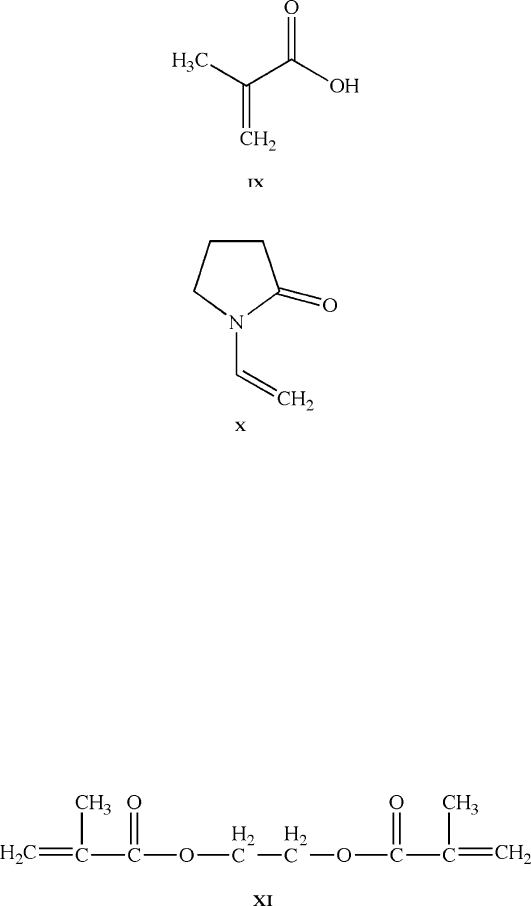
The earliest soft lenses were fabricated from polymers such as PHEMA, later
crosslinked with monomers such as ethylene glycol dimethacrylate (EGDMA, XI).
These polymeric materials are classified as hydrogels since they are extremely
hydrophilic, being able to absorb 10–1,000 times their dry weight of water . The
polymer chains of hydrogels are normally decorated with hydrophilic groups such as
—OH or —COOH to facilitate H-bonding with surrounding water molecules. The
copolymerization of hydrogels with MAA and NVP will yield a polymer with much
greater moisture content – up to 70% for modern lens designs. Network formation
may be afforded by entanglement of (co)polymer chains, covalent crosslinking,
or association of polymeric units via ionic or intermolecular forces (Figure 5.49).
The water within hydrogels is either strongly bound or freely exchangeable, which
is also paramount regarding their use as drug- delivery agents (e.g., Figure 5.50) and
mineralization media.
[79]
The latest varieties of contact lenses are based on silicones, first brought to the
commercial market by Bausch & Lomb (PureVision
TM
)
[80]
and Ciba Vision (Focus
5.3. “Soft Materials” Applications: Structure vs. Properties 405
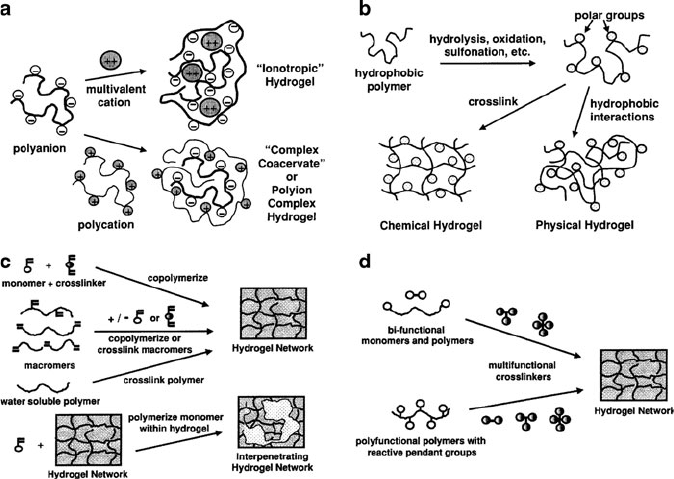
Night & Day
TM
). The primary benefit of silicone hydrogels is their significantly
greater water capacity, while retaining the comfort, wetability, and biofilm resis-
tance of non-silicon based hydrogels. However, due to their pronounced hydropho-
bicity, the oxygen permeability of silicone hydrogels decreases exponentially as
water content increases (Figure 5.51). Consequently, there has been much research
devoted to improving their wetability via surface functionalization to replace silox-
ane groups. Thus far, this has been successfully accomplished by grafting polyox-
yethylene to the surface, as well as using surfactants containing copolymers of
lauryl-, hexyl-, and methyl-methacrylate and polyethylene glycol methacrylate.
[81]
The flux of oxygen through a polymeric contact lens is governed by Fick’s Law
(Eq. 5). In fact, Fick’s law is used to predict the shel f life for food/beverages that
are encased within polymeric packaging (e.g., polyethylene terephthalate (PET),
etc.). The units of transmissibility are 10
9
cm s
1
mLO
2
mL
1
mmHg
1
, which is
equivalent to units of Barrer cm
1
. The first RGP lenses exhibited Dk/t values of
<12 Barrers cm
1
, corresponding to a lower oxygen flu x than a cornea of a non-
Figure 5.49. Four techniques used to synthesize hydrogels. (a) ionic hydrogel formation by gelling a
polyelectrolyte solution with a multivalent ion of opposite charge (e.g., sodium alginate + CaCl
2
), or by
mixing polyanion and polycation solutions to form a complex gel (e.g., sodium alginate + polylysine);
(b) chemical conversion of a hydrophobic polymer (e.g., partial hydrolysis of acetate groups in PVAc to
—OH groups in PVA); (c) copolymerization of a monomer and crosslinker in solution via free radical
reactions (e.g., crosslinked PHEMA and PEG gels); (d) crosslinking of polymers in solution (or solid
state) with multi-functional reactive compounds (e.g., PEG + diisocyanate to yield a PU hydrogel).
Reproduced with permission from Adv. Drug Deliv. Rev. 2002, 43,3.
406 5 Polymeric Materials
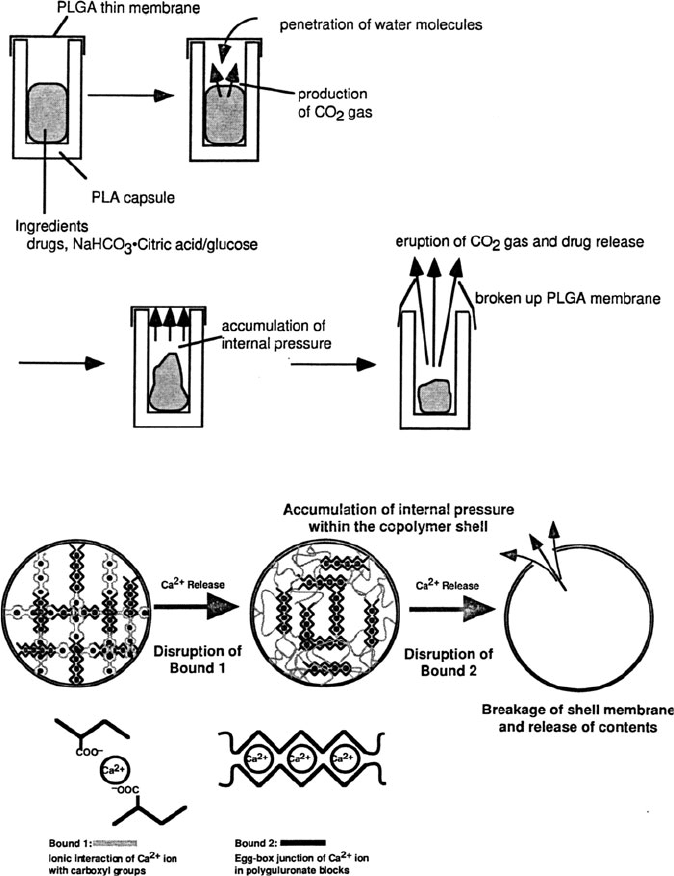
Figure 5.50. Examples of drug delivery using hydrogel membranes. Top: carbon dioxide gas pressure
causes rupture of membrane, controlled by the membrane thickness and amount of CO
2
being produced.
Bottom: drug release from a polysaccharide alginate capsule, facilitated by multivalent/monovalent ion-
exchange, controlled by the molecular weight of the alginate and size of the capsule. Reproduced with
permission from Adv. Drug Deliv. Rev. 2002, 54, 53.
5.3. “Soft Materials” Applications: Structure vs. Properties 407
